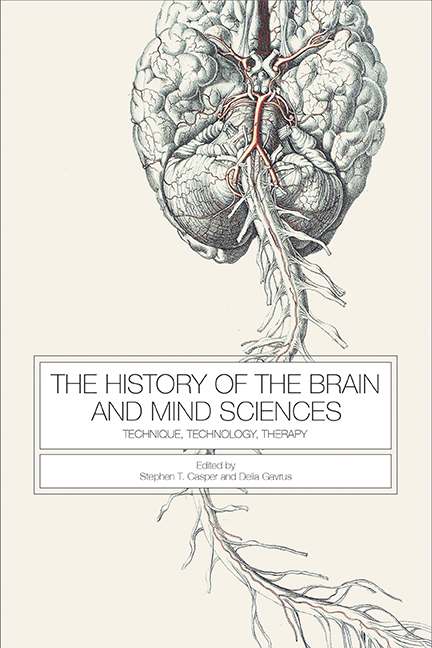Book contents
- Frontmatter
- Contents
- Acknowledgments
- Introduction
- 1 “We Are Veritable Animals”: The Nineteenth-Century Paris Menagerie as a Site for the Science of Intelligence
- 2 “Physiological Surgery”: Laboratory Science as the Epistemic Basis of Modern Surgery (and Neurosurgery)
- 3 Configuring Epidemic Encephalitis as a National and International Neurological Concern
- 4 Circuits, Algae, and Whipped Cream: The Biophysics of Nerve, ca. 1930
- 5 Epilepsy and the Laboratory Technician: Technique in Histology and Fiction
- 6 “What Was in Their Luggage?”: German Refugee Neuroscientists, Migrating Technologies, and the Emergence of Interdisciplinary Research Networks in North America, 1933 to 1963
- 7 Dualist Techniques for Materialist Imaginaries: Matter and Mind in the 1951 Festival of Britain
- 8 A “Model Schizophrenia”: Amphetamine Psychosis and the Transformation of American Psychiatry
- 9 Salvation through Reductionism: The National Institute of Mental Health and the Return to Biological Psychiatry
- Coda: Technique, Marginality, and History
- Bibliography
- List of Contributors
- Index
3 - Configuring Epidemic Encephalitis as a National and International Neurological Concern
Published online by Cambridge University Press: 26 May 2021
- Frontmatter
- Contents
- Acknowledgments
- Introduction
- 1 “We Are Veritable Animals”: The Nineteenth-Century Paris Menagerie as a Site for the Science of Intelligence
- 2 “Physiological Surgery”: Laboratory Science as the Epistemic Basis of Modern Surgery (and Neurosurgery)
- 3 Configuring Epidemic Encephalitis as a National and International Neurological Concern
- 4 Circuits, Algae, and Whipped Cream: The Biophysics of Nerve, ca. 1930
- 5 Epilepsy and the Laboratory Technician: Technique in Histology and Fiction
- 6 “What Was in Their Luggage?”: German Refugee Neuroscientists, Migrating Technologies, and the Emergence of Interdisciplinary Research Networks in North America, 1933 to 1963
- 7 Dualist Techniques for Materialist Imaginaries: Matter and Mind in the 1951 Festival of Britain
- 8 A “Model Schizophrenia”: Amphetamine Psychosis and the Transformation of American Psychiatry
- 9 Salvation through Reductionism: The National Institute of Mental Health and the Return to Biological Psychiatry
- Coda: Technique, Marginality, and History
- Bibliography
- List of Contributors
- Index
Summary
Novelty and Scale
The history of epidemic encephalitis offers a profound challenge to any assumption that, in the early twentieth century, pathologies of the nervous system were somehow the exclusive province of a systematic body of specialized knowledge known as “neurology.” Admittedly, the condition only began to receive wide recognition once it had been dubbed “encephalitis lethargica,” a term which certainly sounds sufficiently neurological, as it describes a site (the encephalon, the brain), a pathological state (-itis, an affliction or inflammation), and a primary symptom (a profound lethargy). Its neurological pedigree might also be inferred from the fact that it was a neuroanatomist, Constantin von Economo (1876–1931), who, based upon his bedside and postmortem observations in a Viennese neuropsychiatric clinic, gave the condition its name in 1917. Economo's description of feverish and sleepy patients with unusual ocular palsies quickly spread. By the end of the following year, dozens of European and American medical practitioners, many of them claiming some expertise in nervous pathologies, had taken up Economo's term to describe this strange new disease. But the novelty, the epidemic character, and the protean nature of encephalitis lethargica quickly served to breach the boundaries of neurological expertise. Commentators debated whether the disease was truly new or whether it had simply been overlooked in the past. But all agreed its complex symptomatology made it extremely difficult to diagnose. In the absence of clear, standardized neurological or immunological signs (as could be found in cases of syphilis or meningitis), the only way to better understand the disease was to gather together more cases. But encephalitis lethargica's epidemiological profile was occult, at best. The causal organism was unknown, and it was unusual to find even two fresh cases in a single institution (never mind a household). Extending disease surveillance (then described as medical or epidemic “intelligence”) was therefore a priority. And the only way to accomplish that was to move beyond the little world of the neurologists (to adapt a phrase from Ludwik Fleck) and enroll a wider range of other practitioners and publics.
- Type
- Chapter
- Information
- The History of the Brain and Mind SciencesTechnique, Technology, Therapy, pp. 77 - 106Publisher: Boydell & BrewerPrint publication year: 2017



